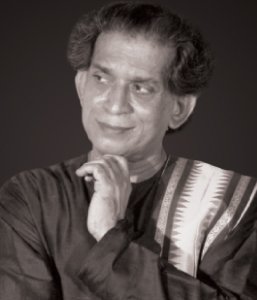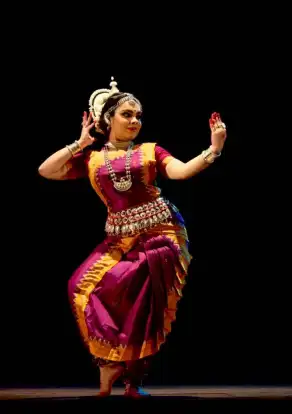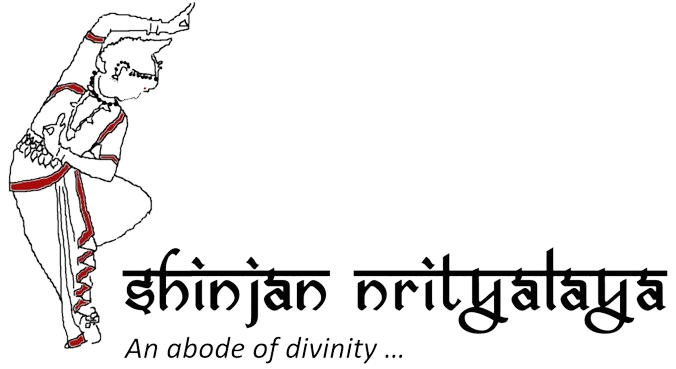
By Shreelina Ghosh
The stars were aligned perfectly and the heaven conspired lovingly when a little boy was born in the tiny village of Parikula, an hour to the west of Puri, on 10th July, 1948. Guru Gangadhar Pradhan was Nataraja Shiva’s chosen one from early childhood when his parents dedicated his life to the Lord in return of his good health. As he grew up, he learned Gotipua dance and then Odissi from the doyens and went on to become one of the most revered Gurus of Odissi.
On a scorching day in the summer of 2008, I went to Odisha for my doctoral field research. When I called Gangadhar Guruji on his phone while in Bhubaneswar, he generously agreed to talk to me the very next day. I was blessed to have lunch with him and his students at the Konark Natya Mandir, a sanctuary of art. I did not know that I was celebrating his 60th birthday with him that afternoon and that he would pass away a year and half later.

Guru Gangadhar Pradhan
We talked about the topic of my research on the use of technology in the performance and teaching of Odissi dance. At that time, online teaching was being practiced by two or three dancers across the world and there were a handful of “Learn Odissi” DVDs. Most of the traditional artists across the world I surveyed and interviewed were skeptical with technology potentially spoiling the pristineness sanctity of a two-thousand year old performative tradition.
Over the past decade, tools of technology have evolved and the practice of the dance adapted accordingly. Interestingly, during the 2020 worldwide pandemic, technology has become integral and crucial in bringing the art to rasikas. Although Odissi is no longer an esoteric practice meant only for the eyes of the deities, a digitized pedagogy can potentially lead to dilution of its quality. While we watch our art thrive through technology, we need to be mindful of a few things that Guruji told me about during our meeting. The conversations I had with Guruji 12 years ago have become all the more relevant now.
Here are some excerpts from our beautiful conversation as I sat at his feet on the cool floor of his practice hall with him with my pen, notebook, and tape recorded:
Shreelina: What is the most important responsibility of a Guru?
Guru ji: Guru is an artist who needs to be “awake” all the time when interacting with students. They are responsible for transmitting traditions from one generation to the next to the next. They need to advice, teach, to remember what is traditional.
Shreelina: How much of the practice of Odissi is derived from statues and shastras?
Guru ji: When the dance started ages ago, it had no connection with statues. The Gurus connected with students and that is the connection that helped the memory to stay alive for hundreds of years. It was only in the last 50 years that Gurus saw the sculptures on the temple walls, researched them, and perfected the poses. Dance was happening within the temples of Konarak, Rajarani, Mukteshwar, Lingaraj, and others. Gotipua and Mahari dance was not learned through research. Patachitra, too, was a way of expressing dance poses practiced for hundreds of years. But there was no conscious research or linking with the Shastras or the statues at that time. Nature gave us dance and then we made the connections.
Guru ji demonstrates an abhinaya piece expressing a series of bhavas on Radha’s Vasakasajya moment. Then he connects the natural movements of the body (Arasa when the nayika is tired of waiting in her bed chambers) to the sculptural depictions of Arasa to illustrate how the Odissi body language imbibed Shastras, sculptures, and natural body movements to communicate a complex storyline.
Shreelina: What are the changes of Odissi performance and teaching that you do not approve of?
Guru ji: If you listen to the Internet videos, you can learn the poses. But you have to know the grammatical system and that is where the Guru is important and required. You cannot learn Odissi without thorough practice under a Guru. It is not the same as learning items. That is not Odissi learning. Dancers learn items and then try more creative things with them. They are slipping away from the classical because the Gurus are often not there to help them understand the responsibility of being an Odissi dancer. If a dancer changes the form, context, and costume of Odissi and if they do not perform according to the grammar of classical Odissi dance, they should not call it “Odissi”. They should simply call is “Creative Dance.” The dance of a classical Odissi artiste needs to align with the approved performative grammar that the community recognizes.
Sometimes students are busy and do not have enough time to learn dance the correct way. There videos can be used but the videos, too, then need to demonstrate everything clearly. Each piece needs to be broken down and taught. Learning by copying a video is not enough and not good.
Here Guru ji shows and narrates how the alapadma symbolized a lotus and then the hamsasya mudra around the face demonstrates how the beauty of the face is likened with the beauty of a lotus. Then the bhramara comes and hovers around the beautiful face mistaking it to be a lotus.
Guruji: Copying these pose is different from knowing clearly how the metaphorical use of the mudras.
Shreelina: Would you then say that using these digital technologies may be harming the dance?
Guru ji: Dance is sacred. There might be some compromises with the foundational sacredness of the dance. For instance, traditionally, the presence of the musical instruments was vital and sacred and the dancer would begin the performance with acknowledgement of the instruments by offering obeisance to them. Now that dancers mostly use pre-recorded music in performance, the tradition of touching the instrument and then touching one’s forehead in an act of offering respect has discontinued. While technology will be used and we cannot stop it, there are some things which probably are getting lost.
Videos need to be taken properly and clearly. The gestures need to be visible clearly. You also have to understand that using technologies is helping Odissi go beyond the country. You live in USA, right? How many people in that country know about Odissi because they have seen it through technology? Most of them, right? Use technology the right way. The student might be able to get the “information” on the poses of a dance from a video and replicate them, but she/he needs a Guru to help the learner realize the spiritual significance of the dance. The name of the Guru is therefore undeletable in the experience and process of learning.
Indian classical dance survived through time and foreign invasions and political turmoil due to its ability to adapt. With every adaptation, it evolved. It will be interesting to see how the 2020 pandemic changes the ways in which Odissi is performed and taught. It is, however, very important to keep in mind that across all these years, the foundational values of Odissi (its innate spirituality, sacredness of space, and importance of the Guru) have remained constant. While we cannot expect the dance to remain unchanged and pristine, it is important to adapt, but adapt responsibly.
Dr. Shreelina Ghosh (https://shreelina.com/), Senior Disciple of Guru Smt Aloka Kanungo
Dance Video of Shreelina Ghosh




